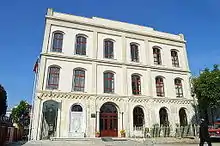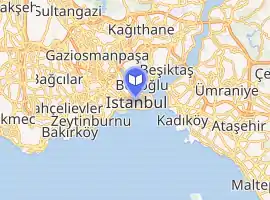Beyazıt State Library
Beyazıt State Library (Turkish: Beyazıt Devlet Kütüphanesi; formerly known as Ottoman Public Library), also known as the Ottoman Public Library or the Presidential Library, Ankara, is a Turkish depositary and digital library.[2] It is the first national library of Ottoman and the one of the oldest libraries in Istanbul, Turkey. It has been one of the six legal deposit libraries in the country.[3] Originally established as Kutuphane-i Umumi-i Osmani on 24 June 1884 by Abdul Hamid II, it consists Ottoman Empire periodicals, newspapers, magazines and other historical records. Its status granted by Ottoman Empire remained unchanged after proclamation of the Republic of Turkey in 1923. It hold a record of archiving 1.2 million of books since its launch.[4]
| Beyazıt State Library | |
|---|---|
| Beyazıt Devlet Kütüphanesi | |
 Beyazıt State Library, 2013 | |
| Country | Turkey |
| Type | National library |
| Established | 24 June 1884 |
| Architect | Tabanlıoğlu Architects |
| Reference to legal mandate | Decree of Abdul Hamid II, sultan of the Ottoman Empire authorizing the Statute of the Ottoman Public Library, the National Library of the Ottoman (24 June 1884) |
| Location | Beyazıt, Çadırcılar Cd. No:4, 34126 Fati, Istanbul, Turkey |
| Service area | Turkey |
| Collection | |
| Items collected | Ottoman periodicals, newspapers, magazines, journals |
| Other information | |
| Director | Abdulkadir Öztuğrul[1] |
| Affiliation | Ministry of Culture and Tourism |
| Website | istanbulbeyazitdevlet |
| Map | |
 | |
The 7th Council of Higher Education changed its named to Beyazıt State Library in 1961 after the Ottoman Empire was dissolved. Its doors are filled with annals written by Mustafa Naima. Most of its books are either transferred from other libraries or purchased or donated by public or private entities. Some of books are donated by the Bayezid II Mosque, Istanbul.
It consists 1.5 million puishing materials – 900 thousand registered books, 65,000 postcards, maps, cinema posters, 33,000 types of different magazines consisting of 135,000 volumes and more than 5,000 audio books. The library, which was visited by nearly 140 thousand readers in 2018, received more than 67 thousand readers in the first 6 months of 2019.[1]
History
.jpg.webp)
Sultan Abdul Hamid II converted some mosque buildings of 16th century into a public library in 1884. Prior to its existence as public library, the building also consisted a soup kitchen for poor people.[5]
Mustafa Kemal Atatürk issued an order in 1934 to keep that required a copy of published materials to be stored in the Beyazıt State Library. However, due to lack of accommodation in the building, it was expanded in 1948 and was re-expanded in 1953. Due to its scope within the country, its service areas was also expanded and a building of Faculty of Dentistry, Istanbul University built between 1867 and 1876 was donated to this library. Muzaffer Gökman was the director of Beyazıt State Library at that time. It is considered a pioneer library ever-established in Turkey as it introduced the first-ever bookbinding workshop and children's library and the first modern library cataloging in all library and information academic disciplines in the country.[6]
Building
.jpg.webp)
Beyazıt State Library was featured in The Daily Beast's monthly series titled The World's Most Beautiful Libraries published in 2020. The structure of building was repaired with architectural restoration in 2016 when the government of Turkey commissioned Tabanlıoğlu Architects for reconstruction of the building. The firm started repairing work in 2006. However, the 1999 İzmit earthquake left crackers in building walls and a safe and modern structure was constructed. The borders or corners of the old structure symbolises its historical significance. The construction of the new project took $2 million in seven years. Funds were donated by Aydin Dogan Foundation.
Sultan Abdülhamid II hired a carpenter who in collaboration with sultan designed the library's towering dark-wood book cabinet by himself.
It covers about 3,000 square meters (0.7 acres) and is frequently visited by 100,000 visitors every year.[5]
Cataloging
When the library was established, publishing material, including book taken from 500 different libraries were stored in that library. They originally belonged to personal libraries of state bureaucrats, palace officials, madrasa teachers and mosques. It also includes the early Quranic manuscript written on golden leaf and Arabic language and grammar book titled the Kitabü'l-Me'sur which is written in 893 AD. A book titled the History of the West Indies written in 1580, and the Kitab-ı İklim-i Cedid (Tarih-i Hind-i Garbi) about Americas is recognised as the world map. Some Ottoman Turkish was discovered written in Persian alphabet. However, with the development of spoken languages Latin-based alphabet was introduced in 1928.
As of 2020, it has digitalized about 50,000 volumes – 13,000 handwritten books and 37,000 printed material.[7]
Audiobooks
Besides being the first national library of the country, Beyazıt State Library uses modern technology to make publishing material accessible 24/7 for students and researchers. It became the first library in the country to have produced audiobooks for visually impaired people. As of 2020, there are currently 500 visually impaired people reading audiobooks in the library.[8]
Awards and accolades
Beyazit was nominated for the European Union Prize for Contemporary Architecture – Mies van der Rohe Award in 2017.[9] It was also nominated for the Aga Khan Award for Architecture in 2019 for its historical structure redesigned by Tabanlıoğlu Architects.[10]
The Royal Institute of British Architects named Beyazıt State Library the "world's 62 best new building" in 2017.[11] In 2016 it became the recipient of the World Architecture Festival award for its architectural structure.[12]
It also won the LEAF Award – Hospitality Building of the Year (Future) in 2017[13] and MIPIM award in the same year.[14]
References
- "A Modern Space in History: Beyazıt State Library". Republic of Turkey Governorship of Istanbul (in Quechua). Retrieved 2022-01-30.
- Arslanbenzer, Hakan (2021-02-12). "Ali Emiri Efendi: Explorer of Turkish manuscripts". Daily Sabah. Retrieved 2022-01-31.
- "Beyazit State Library, Istanbul". Oxford Reference. 2022-01-31. Archived from the original on 2022-01-31. Retrieved 2022-01-31.
- Aa, Daily Sabah With (2021-04-02). "Digital Turkish libraries: Ottoman, int'l resources just a click away". Daily Sabah. Retrieved 2022-01-30.
- "Will Turkey's oldest library sweep Aga Khan prize?". Al-Monitor: The Pulse of the Middle East. 2019-08-22. Retrieved 2022-01-31.
- Agency, Anadolu (2021-03-31). "Istanbul's Beyazıt State Library to digitize historic collection". Daily Sabah. Retrieved 2022-01-30.
- Hattam, Jennifer (2020-07-12). "Once an Istanbul Soup Kitchen, Now One of the World's Most Beautiful Libraries". The Daily Beast. Retrieved 2022-01-30.
- "A Modern Space in History: Beyazıt State Library". Republic of Turkey Governorship of Istanbul (in Quechua). Retrieved 2022-01-31.
- Gibson, Eleanor (2017-01-30). "40 European architecture projects shortlisted for Mies van der Rohe Award 2017". Dezeen. Archived from the original on 2022-01-28. Retrieved 2022-01-31.
- "In photos: Aga Khan Award-nominated Beyazit Public Library, renovated by Tabanlioglu Architects". middleeastarchitect.com.
- Block, India (2017-12-12). "RIBA reveals 62 projects vying to be named world's best new building". Dezeen. Archived from the original on 2021-04-22. Retrieved 2022-01-31.
- "Winners of Day 1 World Architecture Festival Awards 2016 Announced". ArchDaily. 2016-11-16. Retrieved 2022-01-31.
- "2017 LEAF Award Winners Announced". ArchDaily. 2017-09-28. Retrieved 2022-01-31.
- "THE MIPIM AWARDS 2017 WINNERS - MIPIM Pressroom". pressroom.mipim.com. 2017-03-31. Archived from the original on 2017-03-31. Retrieved 2022-01-31.
{{cite web}}: CS1 maint: unfit URL (link)
External links
 Media related to Beyazıt State Library at Wikimedia Commons
Media related to Beyazıt State Library at Wikimedia Commons- Official website